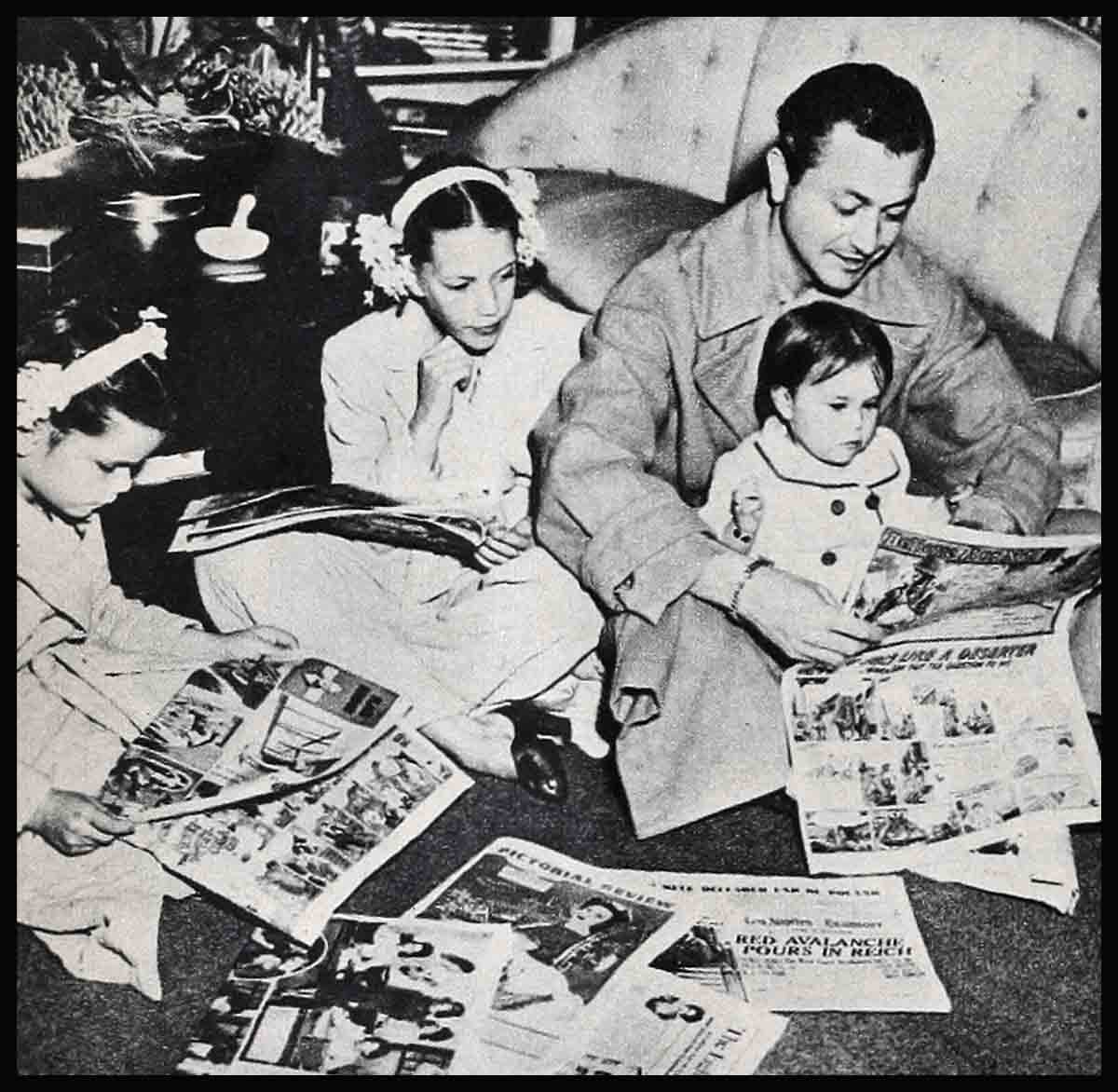
If You Were Bob Young’s House Guest
If you were a house guest of the Robert Youngs, you’d be in for the most crowded housing condition in Hollywood—and therefore a terrible crick in your neck! What’s more, you’d be in for the time of your life!
But in the beginning, you’d just be an out-of-town guest, out of all chances of a hotel room. So you’d finally put in a desperate phone call to your good friends the Youngs, and Mrs. Young would tell you, “It’ll have to be a couch because we’re packed in like sardines ourselves—but come right ahead!” You promptly hop a taxi and finally it deposits you on a quiet, tree-lined street very conveniently near Beverly Hills village, before a white stucco two-story house with leaded windows and a green-shingled roof. You ring the bell, and wait. Silence greets you. You’re telling yourself, “They’ve got to be home—with all those kids in the family!”—when a station wagon wheels into the driveway and you hear Mrs. Robert Young’s voice calling warmly to you.
At first sight of the station wagon you’d swear it was a school bus jammed with girl students. Then you realize that behind Betty are only three girls—and all hers! They are Carol Anne, aged eleven; Barbara Queen (named for her mother’s maiden name), aged seven; and Betty Lou, aged two. They tumble out of the car and surround you, and over their bouncing heads you watch Betty emerge, and you think again that she’s one of the prettiest wives in Hollywood arid one of the best dressed. Now her sleek red hair and her wide green eyes are set off by a simple kelly green slack suit which almost completely hides the fact that she’ll be a mother again in October. She tells you all in one breath that Bob isn’t home from the studio yet, and that she had to pick up Carol and Barbara at their music lesson.
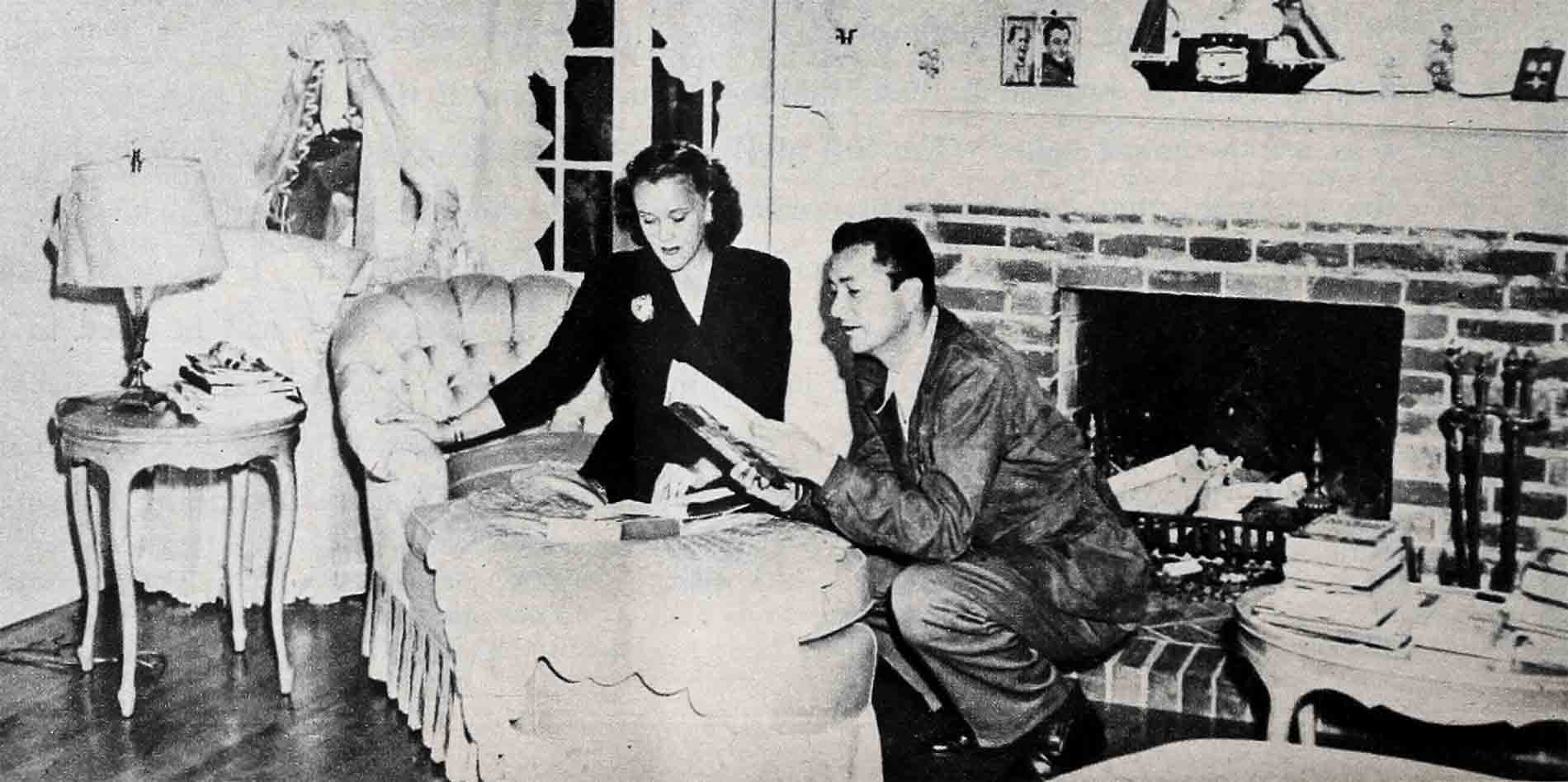
Now she unlocks the front door and all of you swarm into the circular entrance hall. You get a brief impression of a round red fringed rug on a flagstone floor, of blue wallpaper, of a towering grandfather’s clock circa 1810, of a tiny mahogany table holding gold-scales made of brass and holding potted ferns instead of nuggets. Then you’re dragged into the living room, propelled on all sides by Carol, Barbara, and Betty Lou. “We’ll entertain you while Mother gets our dinner!” they tell you. While the girls talk, you peer around at the big and gracious living room.
It has a high-beamed white ceiling, white painted walls, green carpeting and some of the loveliest antique furniture you’ve ever seen. Before the brick fireplace are two pale yellow love seats facing a sturdy mahogany coffee table with knicknack shelves around its sides. A long row of old pewter beer steins march along the top of a built-in bookcase on one side of the fireplace, from thimble-size to quart-size . . . but then, Betty likes pewter; for across the room is a floor lamp whose stand is topped by an ancient pewter teapot. Pale yellow drapes with a green floral pattern bring out the green easy chairs scattered around the room and accentuate the luster of mahogany. You notice built-in bookcases flanking the hearth, crammed with books.
But right here comes the sound of Daddy’s arrival home from work—the roar of a motorcycle coming up the street. A second later Bob Young himself has burst into the room and his three loving daughters are hanging all over him! He’s dressed the way he’s always dressed around home, handy for motorcycle riding or puttering—in tan riding pants, jodhpur shoes and a leather jacket. His dark brown hair is rumpled over his brown eyes and he looks just as healthy and energetic as if he hadn’t been working steadily for months completing “The Enchanted Cottage” and “Those Endearing Young Charms.” He also looks like anything but an actor, and acts accordingly!
“Let’s see how the small fry’s dinner is coming,” he suggests and you find yourself being dynamited into the dining room.

The dining room too is a large, high-ceilinged room furnished in unbelievably beautiful antiques. A pale yellow rug covers most of the burnished wood floor and creamy wallpaper studded with old colonial scenes of boats and buildings covers the walls. The solid oak dining table is as long as a banquet board, the matching chairs are upholstered in plum-colored velvet. A gigantic 16th Century Welsh dresser stands against a side wall, holding about twenty Spode plates. Bob tells you that Betty chose all this furniture, and that all these fine (but giant) pieces were in their San Fernando Valley ranch home originally. “We had to move two years ago, thanks to the children’s schooling and the gas shortage,” he says.
Now he’s interrupted by Betty’s call, “Children—dinner’s ready!” and Bob, grinning, pushes you into the kitchen to watch the children’s evening ritual. You find that Betty has laid out three trays daintily set with supper on the kitchen table; Carol and Barbara promptly pick up theirs and carry them off and Bob takes baby Betty Lou’s and follows, holding his youngest by the hand. You linger for a second with Betty in the cool gray kitchen—it has gray linoleum on the floor, pale gray walls and fluffy white curtains trimmed in bright red. In one corner is a built-in cabinet whose interior is painted a gay red; and this is full of crockery plates and glasses trimmed with red apples. Betty tells you some of her food problems—the Youngs eat twenty chickens and drink 106 quarts of milk a month!
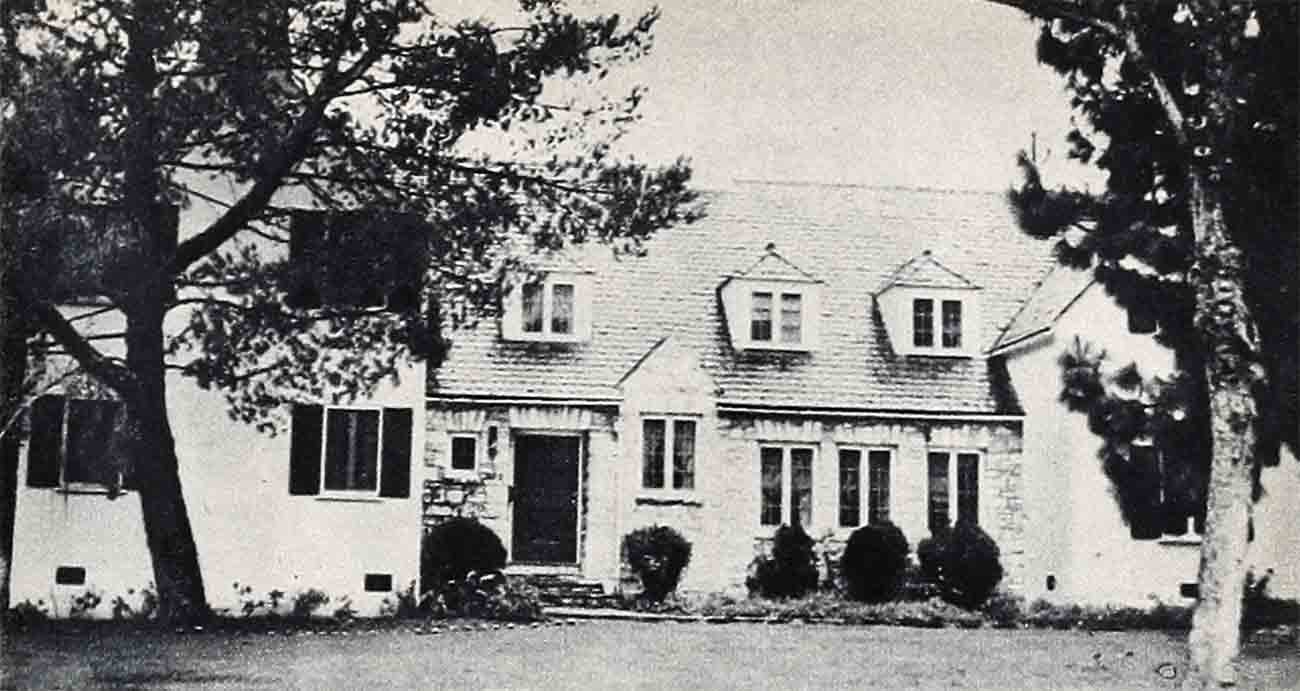
Meanwhile she has led you into the den, which opens off the living room—and which is the hub of the Young family. (It is also going to be your bedroom.) It charms you at sight with its cheerful red rug, white walls, brown beams cutting across the high white ceiling . . . and a small brick fireplace with a fire crackling in it. Carol and Barbara are sitting before the blaze in twin green leather armchairs, eating avidly. Bob is assisting Betty Lou to her dinner at the backgammon table.
Betty and Bob settle down to talk to their children while supper is being put away, and you realize that this is a nightly visiting hour for them. So you sit quietly, looking around you at the old copper kneading bowl on four small legs which stands before the fireplace, filled to over-flowing with nuts and apples. You also notice the soft-drink bar which looks like a hard-drink bar, built into a corner in polished brown wood and faced by square-seated stools upholstered in red leather. At the end of the room is your “bed”—a very short, very pretty tan couch (with arms!). All over the room are Betty’s typical touches—two rare old kerosene lamps on the backgammon table (wired for electricity now, of course); and copper scales and a copper teakettle filled with ivy; and around the hearth copper pans and fire-tools reflect the shine of the big copper apple-and-nut bowl.
By this time the girls have finished supper and Betty herds them off to baths and bed. It seems only a minute later that she’s calling from the kitchen—and you and Bob troop out to get your trays and return to the den with them. You draw a red tray, set with red and white pottery, and you’re eating Bob’s favorite dinner—liver and bacon, corn, peas, a mixed green salad and a chocolate pudding. You’re still in the middle of it when the doorbell rings . . . and suddenly the den is crowded by what Bob calls the “drop-in trade.” By this he means their best friends—Louella Parsons, publicist Margaret Ettinger, the Jimmy Dunns, the Otto Krugers and the Ralph Morgans. During the next hour or so. Bob manages to get them all involved in answering a quiz from a magazine—his favorite sport, and obviously not theirs!
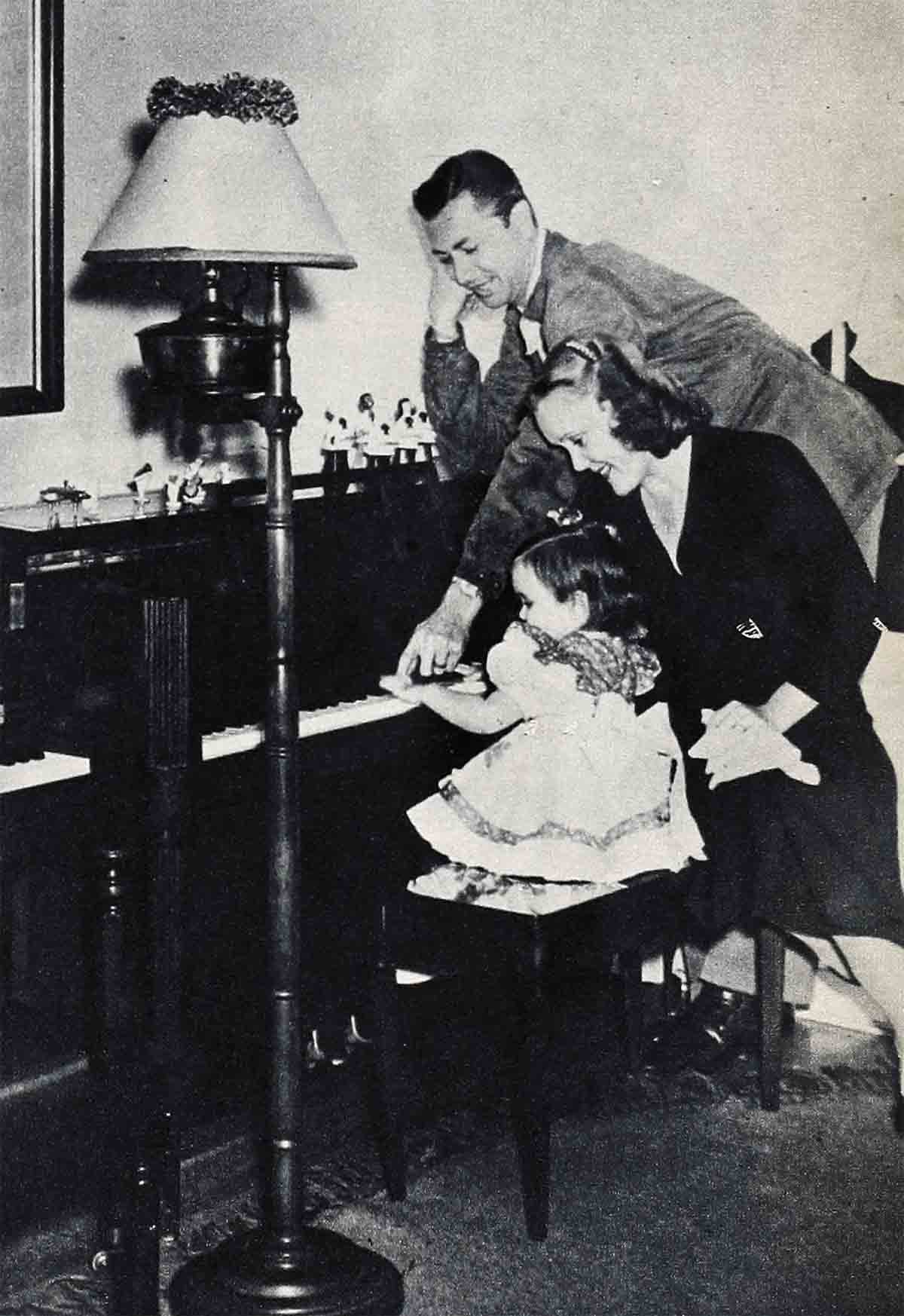
When they leave the Youngs wish you pleasant dreams in your den-bedroom. You don’t have them. That couch is so short you have to let your legs drape over the end-arm . . . and it isn’t until early morning that you finally fall into deep slumber. So you don’t hear Bob’s motorcycle roar past your window at 7 a.m. Neither do you hear Carol and Barbara start off on their morning walk to public school. By the time you’ve faced the new day Betty’s gone marketing in her olive green club coupe and returned again . . . and she’s all set to give you breakfast in the sunny breakfast room.
After breakfast Betty takes you on a tour of the rest of the house—the two deserted maid’s rooms off the kitchen, and still another room you haven’t seen downstairs—the girls’ music room that opens off the circular entrance hall. “This is really the guest bedroom, but our children moved out the guests!” Betty says.
You find two spinettes, side by side, set on a green fringed rug. There are two children’s yellow wing chairs against the white walls—which are decorated by plates trimmed with music notes—but the thing that really catches your eye is a great old music box resting in rusted splendor on a side table. It plays eight tinkly tunes, including “The Past That Breathes Of Thee,” and “Oh, Would I Were A Bird.” In this room, Carol and Barbara practice their daily music lessons.
Upstairs are three bedrooms and three baths—and a hall where Bob had to put the puppet theater he gave the girls, because there was no other place to put it!
But the room that attracts you most upstairs is Bob’s and Betty’s combined sitting room and bedroom. It has a beige pebble-weave rug, white figured wallpaper and floating white ruffled curtains at the windows—and against this background you see a cozy brick fireplace, with an easy chair and a comfortable chaise longue before it, both in gray. Books are heaped in staggered piles all around the floor at this end of the room—and books are jammed into bedside tables flanking the enormous custom-built bed. This bed is six and a half feet by seven feet, with a Louis XIV head-and footboard and it’s covered by a peach colored print satin spread. You note the two easy chairs upholstered to match the spread; and the peach satin dressing table—and the inevitable signs of the Young offspring: Two pastel portraits of Carol and Barbara hanging on the walls, and a pink and blue bassinet standing in readiness in the corner.
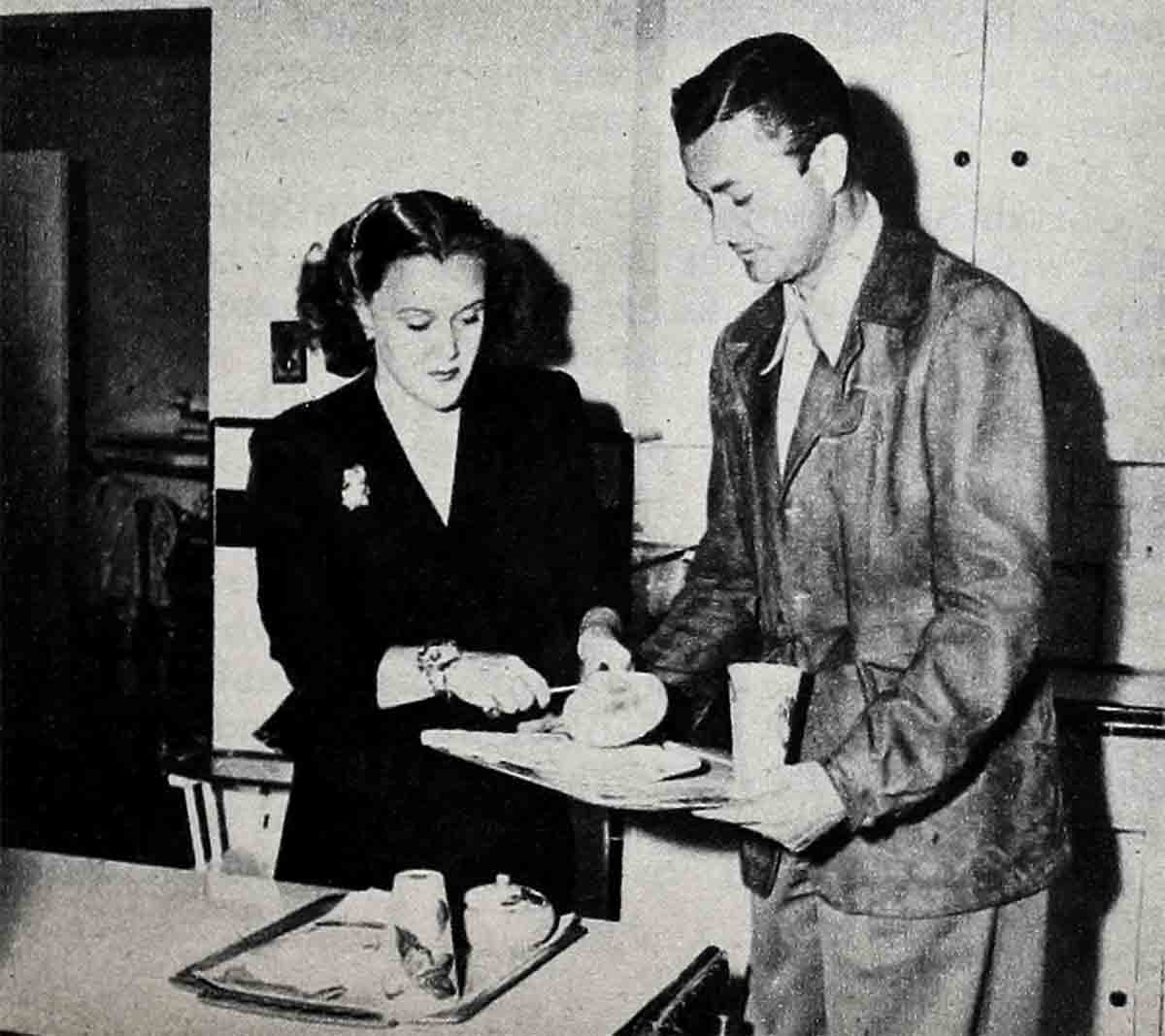
Now the average Young day catches up with you—Betty drives you out to lunch at the studio with Bob to begin with. Then you go with her on her chauffeuring rounds for the children—driving them back and forth to dancing school, music lessons, the dentist. Back home, you’re in on the Friday night schedule—which is dress-up night, to remind the girls that tray dinners aren’t absolutely necessary. Every Friday night the Young family discards comfortable slacks for dressier clothes, eats dinner properly in the dining room and winds up the evening with Bob running off the latest Hollywood movie in the living room. Saturday night you and the Youngs, the Dunns and the Krugers go to dinner at Chasen’s and take in a couple of hours’ dancing at a night club.
But Sunday is your favorite day of your entire visit. For Sunday to Bob Young is his one sure day with his family. They all sleep late, and get up around noon for a waffle breakfast—and then a sharp skirmish between Bob and his daughters over the funny papers. (Bob’s pet is “Blondie.”) All afternoon the girls follow Bob around the house while he mends broken lamps and toys; then the family gathers in the den for a casserole-and-salad supper.
As you can plainly see, the Young family is united and devoted.
And gradually you know other things: That Bob and Betty were married twelve years last March 6th when Bob gave her a present of twelve sapphires set on a platinum bar above a medal—with a regular Army citation inscribed on the medal, congratulating her on her honor and duty under duress! You know that they met in Lincoln High School in Los Angeles when she was thirteen; and that she was born in Kentucky and he in Chicago. You know that after high school she went to the University of Southern California, while he spent five years acting at the Pasadena Community Playhouse. You know that the day she graduated from college, she got her degree at one end of the stadium and Bob’s proposal at the other end—and that they married a year later.
You know that Bob needs ten hours sleep when he’s working; and that he reads steadily and considers “Valley Of Decision” one of the best books he’s run across. You know that he likes Betty’s hair loose (the way she wears it), loves her in green and despises all her bats—which is their sole cause of friction! You know that she buys, and wears, the maddest hats in town; and that Bob is very conservative in the cut of his clothes—but wears them in every color on the palette! You know that on great occasions like birthdays or New Year’s Eve, the whole Young family gets dressed formally for a Young celebration. You know that Bob is only a spasmodic athlete, and then goes in for golf, riding, or badminton; and that he doesn’t care whether his children get A’s in school . . . he wants them to be well-balanced people, not complicated bookworms.
You know that he was the first actor in Hollywood to own a motorcycle—a shiny red one with a sidecar bought specially for Betty. You also know that she rode in the sidecar just once.
You know that the minute the war is over the Youngs will move back to their beloved ranch, with its four guest houses and its swimming pool and its horses on which every Young rides. You know that the second they move back, you’ll move in—sure of a real bed instead of a too-short couch . . . but not at all sure that you’ll have any better time than you’ve had right here, crowded in with one happy family!
THE END
It is a quote. PHOTOPLAY MAGAZINE SEPTEMBER 1945


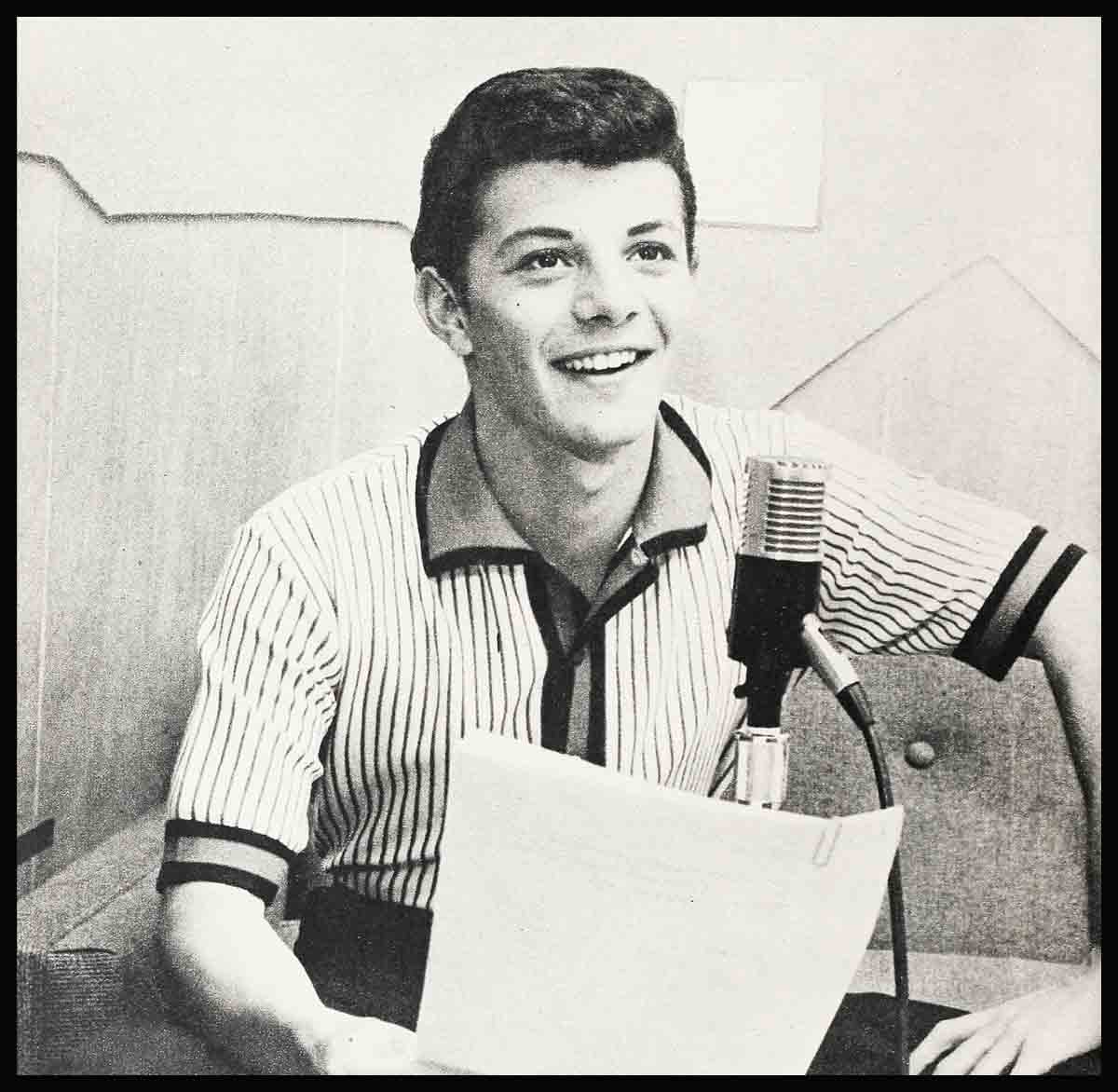
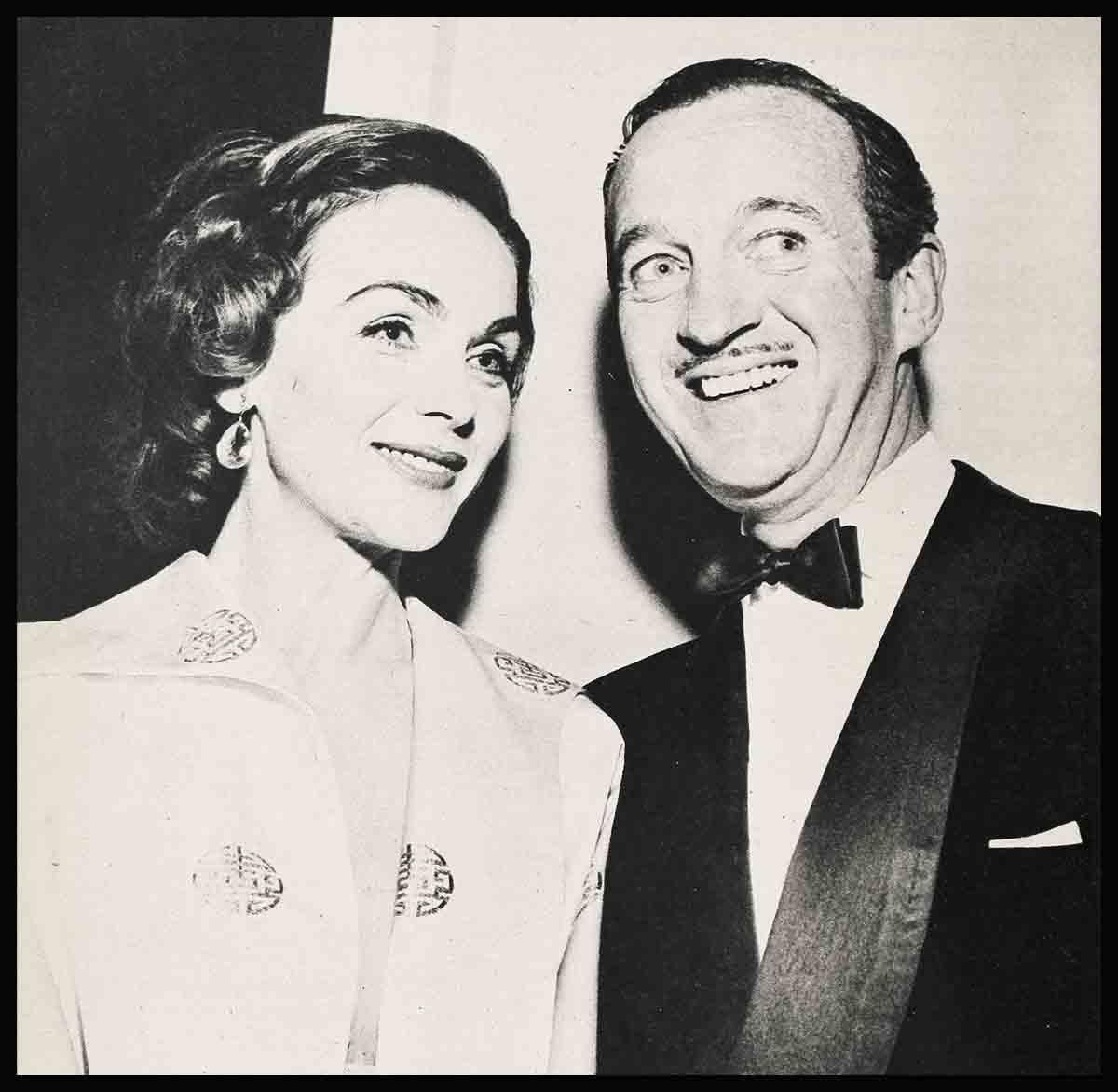
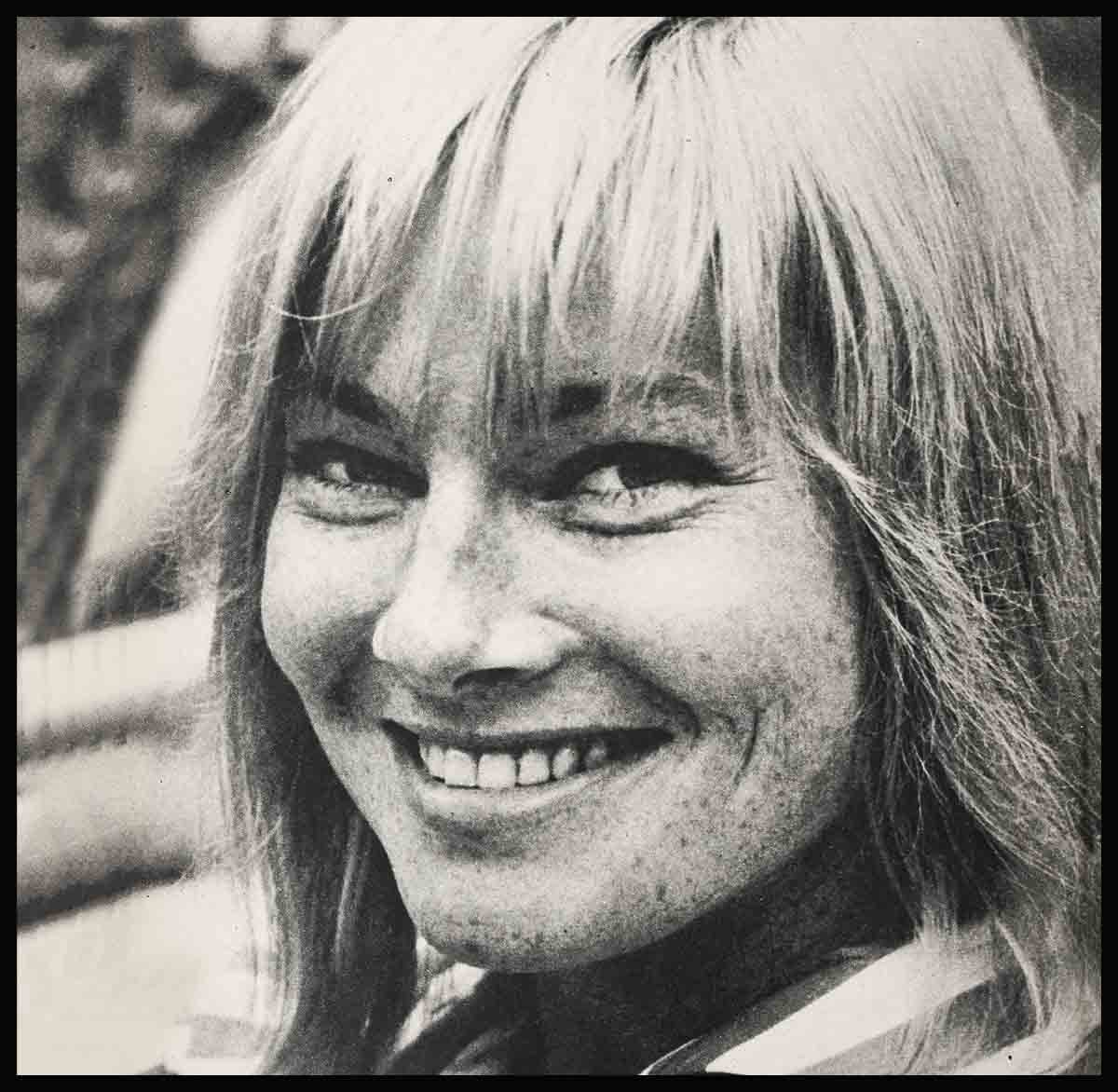
No Comments